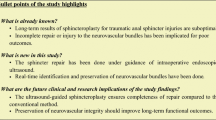Abstract
Introduction and hypothesis
This study emanates from the ISPP OASIS and fecal incontinence study group at the 2018 annual meeting of the International Society for Pelviperineology (ISPP) in Bucharest, Romania. The aim was to analyze the biomechanical factors leading to the breakdown of anal sphincter repair and to suggest a more robust technique for external anal sphincter (EAS) repair.
Methods
Our starting point was what happens to the EAS wound repair site during defecation following EAS repair, with special reference to the process of wound healing.
Results
We concluded that a graft no more than 1 × 1.5 cm sutured across the EAS tear line would mechanically support the tear line, vastly reduce the internal centrifugal forces acting on it during defecation, thereby giving the wound time to heal. Three different grafts were discussed, autologous, biological, and mesh. Also analyzed were the effects on EAS muscle contractility of overly tight repair and overly loose sphincter repair, the latter occasioned by the tearing out of sutures and repair by secondary intention.
Conclusions
We have analyzed causes of sphincter repair failure, introduced a graft method, preferably autologous, for the prevention thereof and supported ultrasound assessment, rather than the absence of fecal incontinence as the criterion for success of EAS repair. Although based on well-established biomechanical principles, our proposal at this stage remains unproven. Our hope is that these concepts will be challenged, clarified, and tested, preferably in a randomized controlled trial.





Similar content being viewed by others
References
Beale RM, Petros PE. Passive management of labour may predispose to anal sphincter injury. Int Urogynecol J. https://doi.org/10.1007/s00192-019-04183-6.
Pinta TM, Kylanpaa ML, Salmi TK, Teramo KA, Luukkonen PS. Primary sphincter repair: are the results of the operation good enough? Dis Colon Rectum. 47:18–23.
Sultan AH, Thakar R. Posterior compartment disorders and management of acute anal sphincter trauma. In: Santoro GA, Wieczorek AP, Bartram CI, editors. Pelvic floor disorders. Milan: Springer; 2010.
Oliva F, Via AG, Kiritsi O, Foti C, Maffulli N. Surgical repair of muscle laceration: biomechanical properties at 6 years follow-up. Muscles Ligaments Tendons J. 2013;3(4):313–7.
Gordon AM, Huxley AF, Julian FJ. The variation in isometric tension with sarcomere length in vertebrate muscle fibres. J Physiol. 1966 May;184(1):170–92.
Douglas DM. The healing of aponeurotic incisions. Br J Surg. 1952;40:79–84.
Kragh JF Jr, Svoboda SJ, Wenke JC, Ward JA, Walters TJ. Epimysium and perimysium in suturing in skeletal muscle lacerations. J Trauma. 2005;59:209–12.
Yamada H. Aging rate for the strength of human organs and tissues. In: Evans FG, editors. Strength of biological materials. Baltimore: Williams & Wilkins;1970. p. 272–280.
Wagenlehner F, Andrei Muller-Funogea I-A, Perletti G, Abendstein B, Goeschen K, Inoue H, et al. Vaginal apical prolapse repair using two different sling techniques improves chronic pelvic pain, urgency and nocturia—a multicentre study of 1420 patients. Pelviperineology. 2016;35:99–104.
Abdool Z, Sultan AH, Thakar R. Ultrasound imaging of the anal sphincter complex: a review. Br J Radiol. 2012;85(1015):865–75. https://doi.org/10.1259/bjr/27314678.
Petros PE, Swash MA. The musculoelastic theory of anorectal function and dysfunction in the female. J Pelviperineol. 2008;27:89–93.
Author information
Authors and Affiliations
Contributions
All authors: conceptualization, planning, writing; P.P.: figures.
Corresponding author
Ethics declarations
Conflicts of interest
None.
Additional information
Publisher’s note
Springer Nature remains neutral with regard to jurisdictional claims in published maps and institutional affiliations.
From the International Society for Pelviperineology (ISPP) OASIS and fecal incontinence study group
Rights and permissions
About this article
Cite this article
Petros, P., Sivaslioglu, A., Bratila, E. et al. A biomechanically based concept for a stronger obstetric anal sphincter repair. Int Urogynecol J 31, 2399–2403 (2020). https://doi.org/10.1007/s00192-020-04350-0
Received:
Accepted:
Published:
Issue Date:
DOI: https://doi.org/10.1007/s00192-020-04350-0




